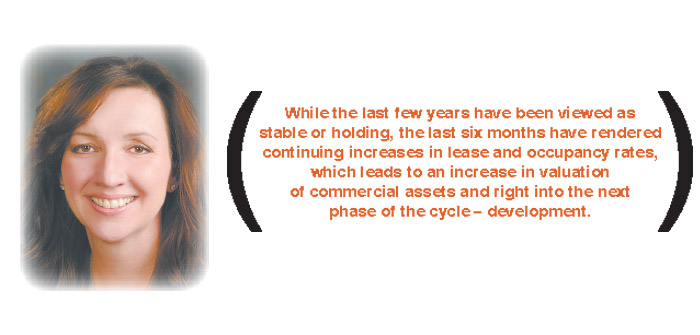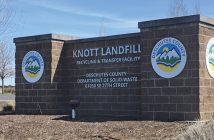The energy and enthusiasm in the Central Oregon economy is palpable. The buzz of businesses thriving, the vitality of start-ups and the economic diversification is moving commercial real estate in a direction we haven’t seen for a long time…up!
While the last few years have been viewed as stable or holding, the last six months have rendered continuing increases in lease and occupancy rates, which leads to an increase in valuation of commercial assets and right into the next phase of the cycle – development.
There are several indications of increasing development in Central Oregon commercial real estate:
Strong residential development: Historically, commercial real estate has lagged growth and decline in residential real estate – as go people, so go the jobs, so goes the demand for commercial real estate.
New direction for land sales: Increased listings, and more importantly sales, at higher valuations than we have seen in six or seven years. Investors and developers know Central Oregon needs for office, industrial, and even retail, are increasing.
Declining vacancy rates: Across the primary commercial sectors (office, industrial, and retail), there has been a consistent decline in vacancy. The Bend market is leading the absorption of space, but Redmond, Madras and Prineville are coming along as well.
Deliveries of new development are at a historical low across all sectors across the country (except a few select large markets): Simply put, there is no new inventory coming into the market. In 2013, according to the City of Bend records, only four commercial building permits were issued for new development. Two of these were for the new Walgreen’s on Third and Franklin and on NE 27th and Hwy. 20.
Increase in commercial building permits being issued: In 2014, Bend saw a substantial increase in new commercial building permits being issued (Redmond no longer provide this information online). Including four permits for additions and excluding all commercial remodel permits, 20 permits were issued for new commercial projects for a total of approximately 283,000 SF – about 2.5 percent of the market inventory.
As the market continues to improve, there are considerations for every business or individual touched by commercial real estate.
TENANTS: Now is a critical time to review your lease and to consider your long term plans for your business. While lease rates aren’t going to double overnight, they are going to increase and even more importantly, until a fair amount of the development is completed (at least 12-24 months from now) there are going to be fewer options for relocation. Don’t be afraid to contact your landlord to strategize a plan that works well for both parties. Keep in mind your landlord, like many of us, has weathered a very challenging economic period; they are ready to realize a positive cash flow on their property.
LANDLORDS: As demand increases it will be tempting not to renew leases for existing tenants in hopes of realizing a new tenant that is willing to pay substantially more. If you have quality tenant, it is critical you work with them. Losing a tenant can mean lost cash flow and new expenses such as tenant build-out allowances and additional brokerage commissions, etc. These costs can add up quickly. Instead consider alternatives like ramping the lease rate over time, providing some enhancements that improve the work environment and/or the appeal of the building to the tenant’s clients, or a longer-term lease to increase the stabilization and the overall valuation of your asset.
INVESTORS and DEVELOPERS: Leverage the expertise of your commercial real estate broker for clear commentary on the usability of the asset now and in the future. This is even more critical in an improving market. After a long down turn, and as investors credit is repaired, there is a strong desire by many to get back into the market. This desire can sometimes lead to less than optimal decisions.
Utilize your trusted advisors to collaborate on a project. For developers this means understanding your target market and which tenant-users best fit market demands for the development space needs now and in the future. What are your options for conversion of the building as the market changes?
Investors looking at existing properties should consider what amenities does the asset lack, what is the management need of the building (ask what can we do differently rather than what can we do better), and can we add value with a competitive advantage (which is cash a lot of the time). This is the upside potential.
Overall, the economic indicators are positive. There is more capital available, real disposable income is rising, net worth rebounding, and interest rates remain low. However, it is always important to keep an eye on the indicators that are of possible concern. While U.S. unemployment is at five percent, labor participation is low – people are not coming back into the market (meaning many don’t have money to spend), there is high corporate leverage (low rates make it hard for business to resist), corporate profits are up, but revenue is stagnant (by controlling labor costs), and foreign markets are looking for better investments than their own (as of January 15, 2015 Japan’s 10 year bond is at 0.2 percent, Germany 0.46 percent).
The saying “Never Forget” is mostly associated with the tragedy of 9/11 but for those of us who have survived the last seven years in Central Oregon, it is a saying that rings true. Enjoy the upswing in our economy, it is a great opportunity to revitalize and strengthen our region but “never forget.” Invest and operate with reason and sound analysis and the cycles can be enjoyed and endured.
Andie Edmonds is a partner and principal broker with NAI Commercial Real Estate Services, whose focus is Investment Advisory Service for a select group of clients.
541-306-0042, www.naiaris.com





